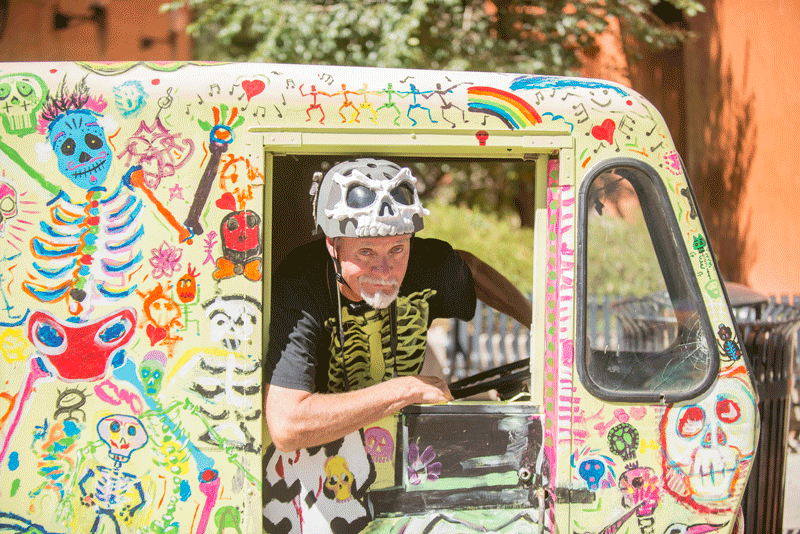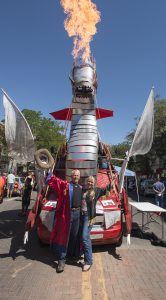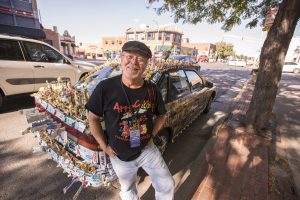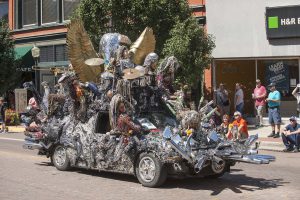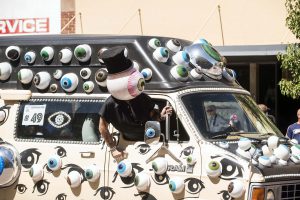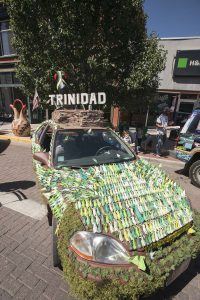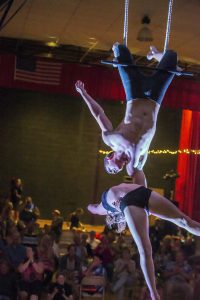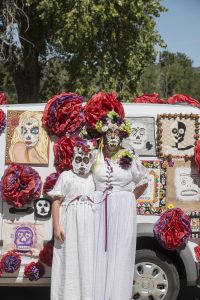By Malia Durbano,
Photography by Dave Neligh –
ArtoCade in Trinidad: A Parade with Punch
Down the street they come: Unrecognizable vehicles covered in shiny beads, colorful crocheted doilies, wild paint, plastic kids toys, quilted fabrics and murals, toting fighter jets, giant grasshoppers, Albert Einstein likenesses, a fire-breathing dragon and other art objects. And that’s just a few of the improbable entries in ArtoCade in Trinidad.
In only the fourth year of its existence, Trinidad’s ArtoCade is now the second largest art car parade in the country.
The “cartists” and admiring art car enthusiasts, who come from all over the country, are amazed at how this small town rose to notoriety in the art car world. About 80 cars, decorated with the craziest and most diverse items you can imagine, will drive down Main Street and back up Elm in Trinidad on Saturday, September 10 at noon. Each entry must be driven. “If you can’t drive it, it’s a float,” proclaims Pat Patrick, former president of the Trinidad Tourism Board. And no floats are allowed in this parade.
Many of the cars parade watchers will see were saved from the junkyard and are on their last legs, but they get lots of tender loving care so they make it through the annual parade.
“People often start with junkers to create art cars,” explains Mark Moffett of Lafayette, who created a few of his own cars and contributed to others. “(They) then embellish them and realize it’s now their most prized possession, and it’s a piece of junk.”
Any vehicle that can be driven and decorated is game. This includes golf carts, tractors, trucks, all-terrain vehicles and motorcycles. Since one of the founding principles is that the event is for the whole family and the whole community, kids get to decorate and ride bikes. Costumes are mandatory; and anyone who wants to join the fun can dress up themselves and walk alongside the moving vehicles. In the true spirit of inclusion, one year there was even a wheelchair decorated like a kissing booth, with the passenger charging for kisses.
The History of ArtoCade
ArtoCade and all its fun has roots in the discontinuation of an annual big summer event in Trinidad that was designed to draw tourists to the southern Colorado town. Patrick approached Rodney Wood, a local artist, for ideas to replace the event. “Pat didn’t want an arts and crafts festival or a beer fest or an artists’ studio tour,” Wood explains. “He wanted a really fun signature event to put Trinidad on the map.” As the halfway point between Santa Fe and Denver, Trinidad is the perfect spot for tourists to lay over.
Wood, who has been in the art world for a long time and has contacts all over the country, started checking around for a really “over the top” event. He wanted it to be inclusive for all community members and involve creativity and fun.
In 2010, he went to the Houston Art Car Parade, the largest in the country. The parade now features more than 300 cars and draws an audience of about 350,000. He brought photos back to Patrick and said, “What do you think?” Patrick grew up in Houston and knew of the parade but never attended.
This looked like just the event he wanted — one that everyone could participate in, be proud of and rally around. It took Wood a year of educating the Trinidad community and networking in Houston to get its Texas car owners to come to Trinidad and generate some excitement about the event.
The Inaugural Draw
Apparently, Wood is also a fabulous salesperson. His goal the first year was to have 20 to 25 cars in the parade. They were amazed to have 52.
The creativity that materialized from the residents of Trinidad and others from throughout the region couldn’t have been anticipated. Each year, there are cars decorated with such things as traffic cones (on the Cona Lisa entry) and cigarette butts (collected from hiking trails, city parks and streets and meticulously placed in beautiful mosaic patterns on Stink Bug, a Volkswagen Beetle).
There aren’t many rules about designing cars for the parade, but Wood is adamant that they not be used for commercialization or politics… unless it’s done with humor. Then he might make an exception. A local pizza parlor, Bella Luna, decorated an old truck and made it look like a boat with a mast and called it Bella Luna Sea (Bella Lunacy).
Most of the cars have names with puns intended. Archie Taylor from Salida drove a giant inflatable pig as a statement against the 1 percent who never have enough. The pig “pooped out” big garbage bags that said such things as Bank Fraud, Corporate Greed and Entitlement.
“This parade is about fun and humor,” Wood explains. “It’s not about the sale of anything or drinking alcohol.”
Everyone Belongs
Jeannie Galbraith, art teacher at Amazing Grace Christian School in Trinidad, is also grateful for Wood’s view on inclusion. Her students in grades 7 through 11 are currently working on a van for this year’s parade. It will have a huge eagle on top made of papier-mâché and have a giant 4-foot-wide Bible with the words “Amazing Grace” on it with the logo of the school. “I’m grateful to be able to include a positive message in the parade and prove that total free expression applies,” she says.
Galbraith, a veteran of art car parades, also expresses her fun side. The first year, she rode the Ultimate Banana bike with a huge banana seat and bananas all over the bike. She dressed up like a monkey and enjoyed the laughter from the crowd. Her daughter, Star, rode a bike that looked like a bird and as she pedaled the bird flapped its wings.
The second year, Star’s bike was covered in fabric and looked like a fish. It represented both the card game Go Fish and the Dr. Seuss book, One Fish, Two Fish, Red Fish, Blue Fish. Large scales were made out of playing cards, a large fishing pole stuck out of the front, pie plates created huge eyeballs and as the head of the fish turned one way, the tail moved in the opposite direction propelled by Star turning her own head. Their creativity proves Galbraith’s belief that creating vehicles for the parade opens up your imagination in a really big way.
Although Rebecca Bass lives in Houston, she came to the Trinidad parade every year so far. Bass, a legend in the art car world, just finished her 35th car. The self-proclaimed “art car addict” confesses that what is most fun for her in building the cars is the kids. Bass works with inner-city middle and high school students to create her cars.
“When it’s done and we’re in the parade and all these people are watching and cheering, seeing the looks on the kids’ faces is priceless,” she says.
Bass often uses her own money to buy the cars and the materials and wants to give the inner city kids a fun experience. “It’s really about stretching their creativity and working together as a team,” she says. She also keeps her ear to the ground, collecting materials that are being discarded that she can get for free.
Moffett, a friend of Wood’s and fellow classically trained artist, likes the freedom of expression provided by creating art cars. He was trained as a metal caster and got tired of the lengthy process of metal fabrication. In graduate school at Bowling Green University in Ohio, he took a class in art car building from legendary David Best. “Art cars remove the stigma of the gallery and let us bring the gallery to the people,” he says.” There is so much more spontaneity.”
He took a VW Rabbit and welded on ductwork that sticks out like giant chimneys. He collected items donated from thrift stores and colorful plastic toys and stuck them all over the car. Stacks of old CDs were layered tightly to look like fish scales.
“When you put them with the silver side out, they shimmer,” Moffett explains. Uncle Benny’s, a store in Loveland, donated giant vapor lights — the kind you see hanging from the ceiling in The Home Depot — and he welded them on the back to create the taillights.
Moffett enjoys offering art car workshops to people who work with their hands, such as welders, pipe fitters and heating and air-conditioning fabricators. “These guys don’t consider themselves artists. They have been doing this for years and don’t realize they have a skill that is a creative art form.”
Wood’s partner in all this zany creativity is Susan Palmer. As Moffett explains, “Rodney and Susan have this infectious energy and are excellent at organizing.” Palmer estimates that parade attendance is at about 5,000 people, which is impressive since the population of the town is only 8,500. The parade already won the Governor’s Award for Excellence in the Best Event for a Small Town category.
This year, taking some responsibility off the shoulders of Wood and Palmer, a board and a committee were formed to help with the festivities and their preparation. Palmer is helping with preparations for Cardango, the variety show on Saturday night. Described as a “dance party circus,” Cardango is all about presenting the interesting, unusual and entertaining oddities to keep people entertained.
Additionally, Palmer, a quilter, gathered 27 community members to decorate a car for last year’s parade called Dia de los Muertos. Fabric artists, a tattoo artist (who painted on fiber) and others created patches with pockets in the back for strong magnets that keep the fabric on the car. Since there is only one driver, the other artists wore white outfits with flowers in their hair and walked alongside the car. “Having everyone participate and being inclusive is very important,” Palmer says.
The spirit of inclusion is taken to a new level by drivers of about 15 to 20 cars who take them to those who can’t make the parade. The Friday before the parade, these volunteers take the cars to schools, nursing homes, the hospital and the local Trinidad Correctional Facility. (See sidebar for more information on TCF’s involvement.)
“The cars have such amazing details,” Wood says.” You really have to see them up close. You also have to see the characters who drive the cars. Normal people don’t do this. We want to tell everyone about the quirky little world we have going on here.”
That’s why, after the parade, the cars park along Main Street. That gives everyone an opportunity to get up close to these works of art and admire them and their fun-loving drivers from every angle.
Visit artocade.com for more information.
Malia Durbano is a freelance writer who taught and worked in many places before finding a new home base in Durango where she works.

